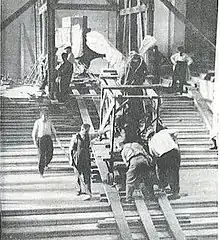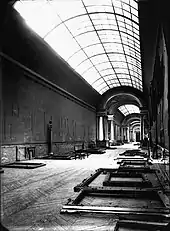Evacuation of the Louvre museum art collection during World War II
During the beginning of the German invasions during World War II, Jacques Jaujard, the director of the French Musées Nationaux, anticipating the fall of France, decided to organize the evacuation of the Louvre art collection in to the provinces.[1]
Evacuation of the art collection


On 25 August 1939, the Louvre was closed for 3 days, officially for repairs. However, much of the Louvre art collection was hauled on trucks (203 vehicles transporting 1862 wooden cases) and sent to Château de Chambord.[2][3] The crates had a marking to identify the importance of the art pieces they contained: a yellow circle for very valuable art pieces, green for major works and red for world treasures (the Mona Lisa was marked with three red circles).
Some of the art pieces were too big to be fit in a truck. For example The Raft of the Medusa had to be covered with a blanket. When the truck initially arrived at Versailles on its route to Chambord, the canvas touched an electric cable and created a short-circuit which switched off the electricity in the whole town. After that, the routes were carefully planned to avoid this type of problem, and attendants with poles were responsible to deal with electric or phone cables.[4][5]
The last art piece to leave the museum was the Winged Victory of Samothrace, which was moved on September 3, 1939, the day the French ultimatum to Germany expired.[6]
Throughout the war, the art pieces were clandestinely moved from chateau to chateau to avoid being taken back by the Nazis.[1] For example, the Mona Lisa was moved from Chambord to several castles and abbeys, to finish at the end of the war at the Musée Ingres in Montauban.[7][8] The Winged Victory of Samothrace and Venus de Milo were kept at Château de Valençay, which was spared the German occupation on a technicality.
The arrival of the German army in Paris
On 16 August 1940, count Franz von Wolff-Metternich, who was responsible of the conservation of the French art collections under the Kunstschutz principle, arrived in Paris to oversee France's art collection, but the museum was almost empty. He knew what was going on but voluntarily did not do anything.[1][9]
See also
References
- "Saviour of France's art: how the Mona Lisa was spirited away from the Nazis". The Guardian. 2014-11-22. Retrieved 2018-01-13.
On 25 August 1939, Jaujard closed the Louvre for three days, officially for repair work. For three days and nights, hundreds of staff, art students and employees of the Grands Magasins du Louvre department store carefully placed treasures in white wooden cases.
- "Le Louvre ou l'art de résister". Le Figaro. 2013-11-13. Retrieved 2018-01-13.
- "How France Hid the Louvre's Masterpieces During WWII". twistedsifter.com. 2013-05-16. Retrieved 2018-01-13.
- Illustre et Inconnu. Comment Jacques Jaujard a sauvé le Louvre
- Nicholas, Lynn H. (1994) The Rape of Europa: The Fate of Europe's Treasures in the Third Reich and the Second World War. New York: Alfred A. Knopf, pp. 54–55. ISBN 978-0-679-40069-1; OCLC 246524635
- "Exode artistique". Le Monde. 2014-10-31. Retrieved 2018-01-19.
- "Did the Nazis steal the Mona Lisa?". The Guardian. 2013-11-12. Retrieved 2018-07-15.
The only wartime documents available about the Mona Lisa say that on 27 August 1939 it was packed in a specially-marked crate, tailor-made in 1938, of double-thick poplar wood. Along with other artworks from French national museums, it was sent for storage, first to Chambord Castle in the Loire Valley. On 5 June 1940, it was transferred to Chauvigny on a cushioned stretcher in the back of an ambulance, which had been sealed to keep the humidity constant (the official who accompanied the painting arrived nearly asphyxiated from the lack of circulation in the sealed vehicle). In September, it moved again, to the Ingres Museum in Montauban, before a final move to Montal in 1942
- "How the Mona Lisa Escaped Destruction During World War II". Mental Floss. 2016-08-25. Retrieved 2018-07-15.
- "In Memoriam - Jacques Jaujard". gallica.bnf.fr. Retrieved 2018-01-13.
Bibliography
- Jean-Pierre Devillers (2015). Illustre et Inconnu. Comment Jacques Jaujard a sauvé le Louvre (Television production). Ladybirds Films.CS1 maint: uses authors parameter (link)